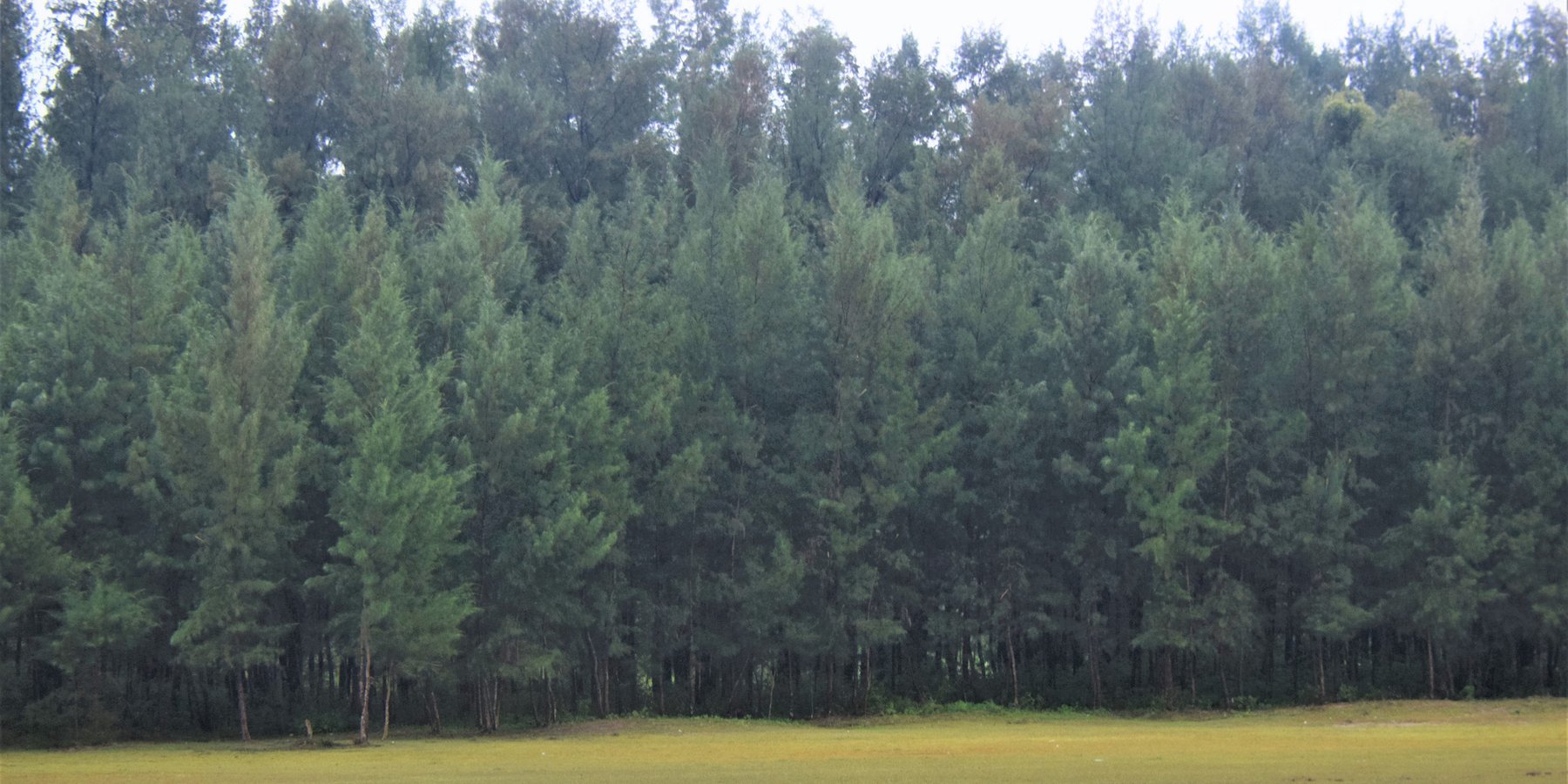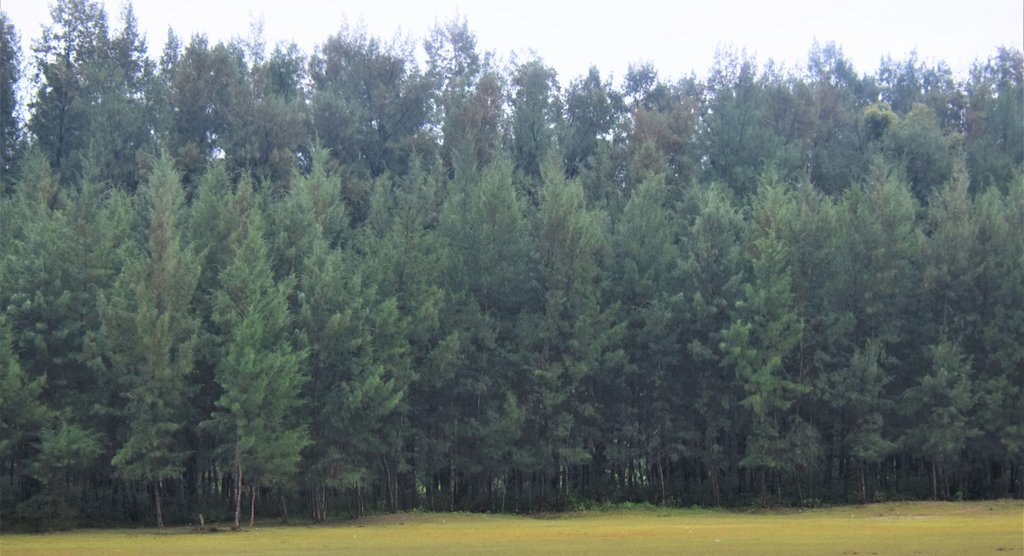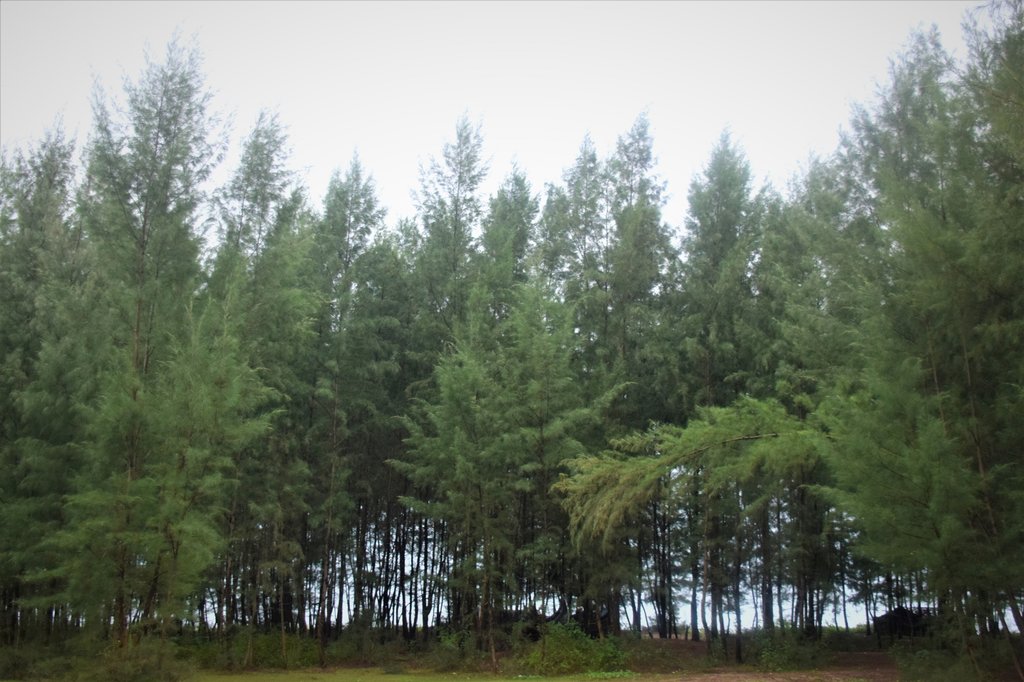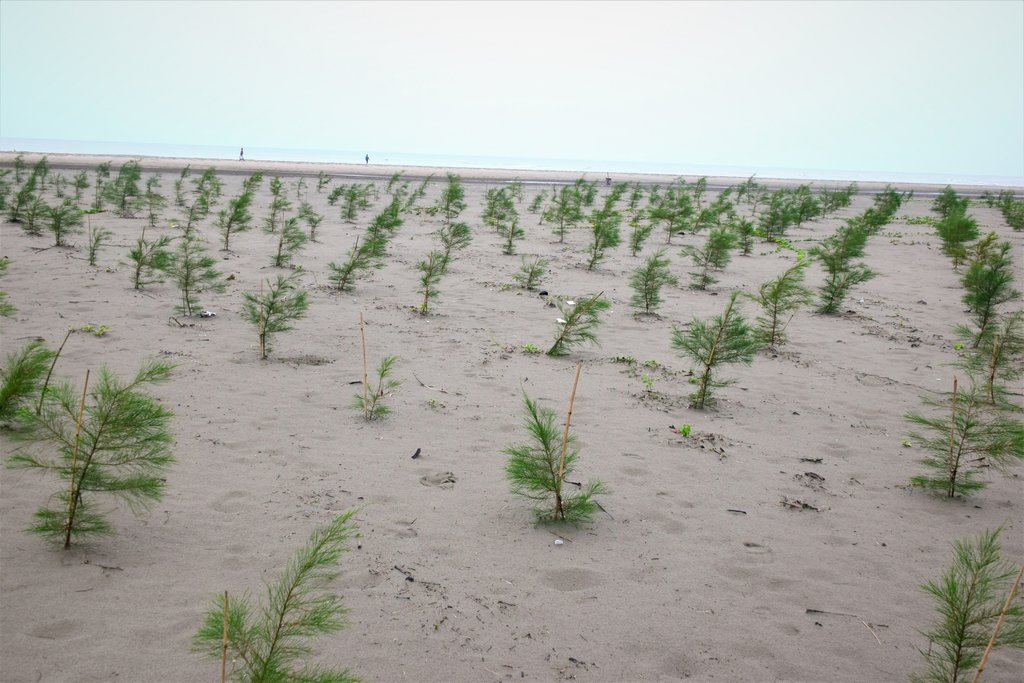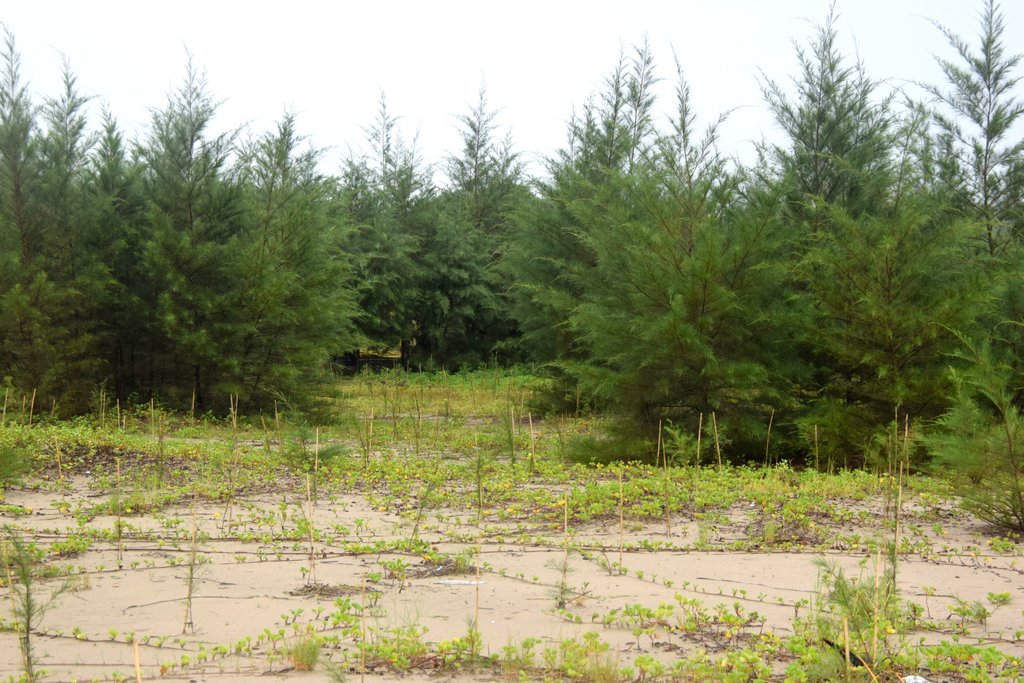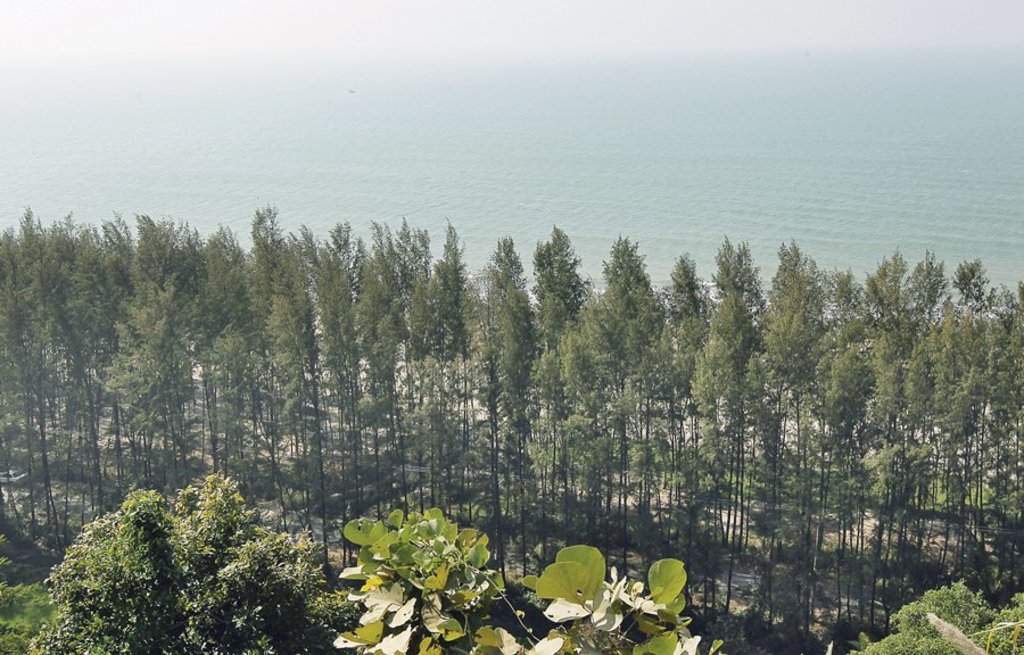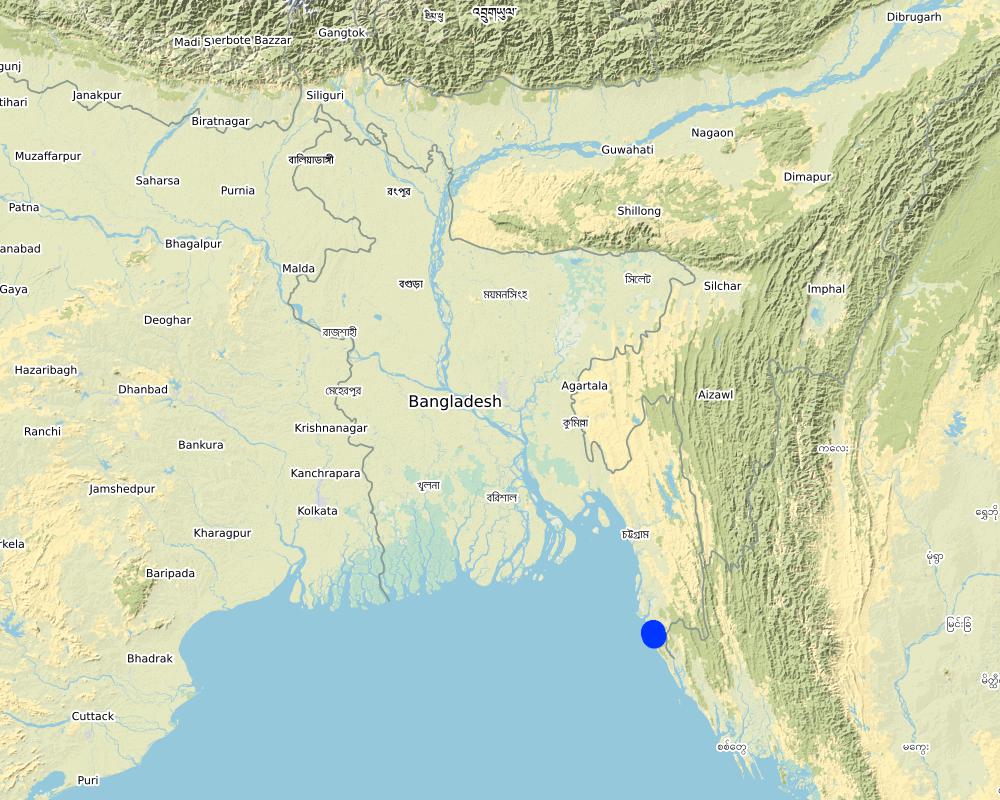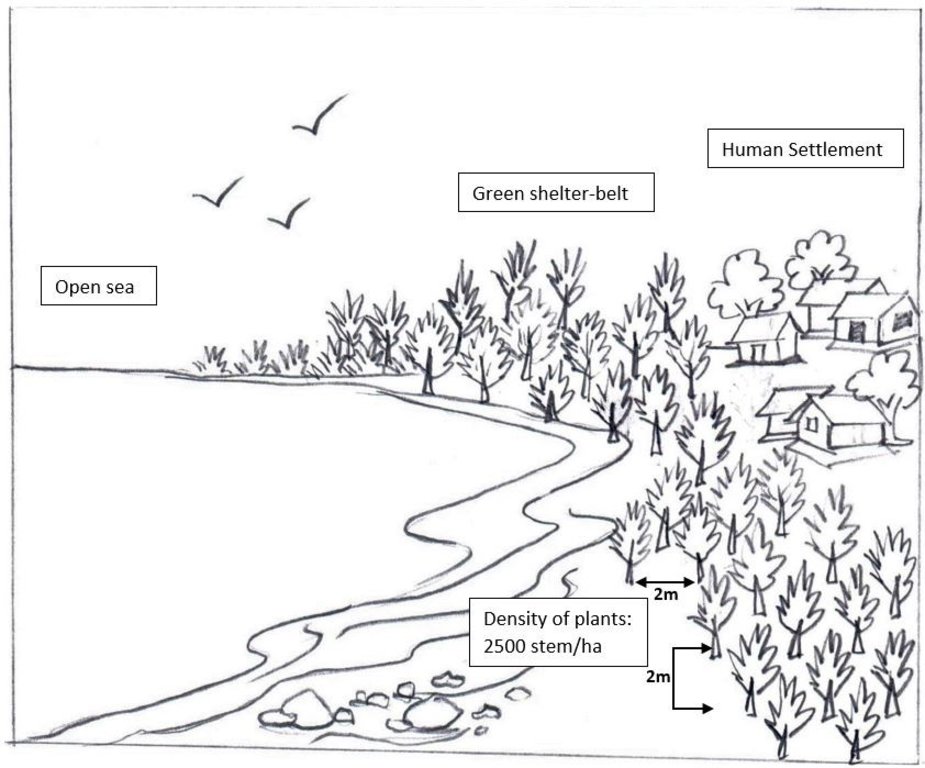Creating green shelter-belt through Jhau (Casuarina equisetifolia) plantation in coastal area [孟加拉国]
- 创建:
- 更新:
- 编制者: Fazlay Arafat
- 编辑者: –
- 审查者: Nicole Harari, Rima Mekdaschi Studer, Ursula Gaemperli
Coastal Greenbelt
technologies_4333 - 孟加拉国
查看章节
全部展开 全部收起1. 一般信息
1.2 参与该技术评估和文件编制的资源人员和机构的联系方式
关键资源人
土地使用者:
Morshed Hoq Mahabub
Bangladesh Forest Department
孟加拉国
土地使用者:
Mondol Dhiman
Bangladesh Forest Department
孟加拉国
土地使用者:
Ali Md. Sobur
Local community people
孟加拉国
有助于对技术进行记录/评估的项目名称(如相关)
Decision Support for Mainstreaming and Scaling out Sustainable Land Management (GEF-FAO / DS-SLM)有助于对技术进行记录/评估的机构名称(如相关)
Bangladesh Forest Department (Bangladesh Forest Department) - 孟加拉国1.3 关于使用通过WOCAT记录的数据的条件
编制者和关键资源人员接受有关使用通过WOCAT记录数据的条件。:
是
1.4 所述技术的可持续性声明
这里所描述的技术在土地退化方面是否存在问题,导致无法被认为是一种可持续的土地管理技术?:
否
2. SLM技术的说明
2.1 技术简介
技术定义:
Creation of green shelter-belt along the coast line through plantation of Jhau (Casuarina equisetifolia) to reduce vulnerabilities and hazards of extreme weather events like cyclones.
2.2 技术的详细说明
说明:
The coastal zone of Bangladesh is extremely vulnerable to the impact of climate change. The coastal populations are mostly poor and some of them are landless with livelihoods connected to agriculture, fishing, shrimp farming, salt farming etc. Past devastating cyclones have killed thousands of people and destroyed homes and infrastructure. Creation of green shelter-belts, including mangrove and non-mangrove plantations, reduces the vulnerabilities and hazards related to extreme weather events like cyclones and storm surges. Afforestation along coastal areas is usually cheaper and ecologically more beneficial than other measures and serves to conserve biodiversity and stabilize newly accreted land. As a general guideline, a shelter-belt protects an area over a distance up to its own height on the windward side and up to 10 times its height on the leeward side, depending on the strength of the wind.
The current sustainable land management practice takes particular account of the Jhau plantation along the coastline of Himchari National Park of Cox's Bazar. Jhau (Casuarina equisetifolia) is one of the most promising non-mangrove species for creating shelter-belts and the Bangladesh Forest Department has been planting them in raised coastal lands and embankments since the 1990s. Casuarina equisetifolia is an evergreen tree with a finely branched, feathery crown and usually growing around 35 meters tall. It is fast growing, salt tolerant, grows in sand and can also tolerate occasional inundation by sea water at extremely high tides. Many areas where the species naturally occurs are susceptible to tropical cyclones, and its general tolerance to strong winds has encouraged its use in protective planting. The most common uses of C. equisetifolia are for coastal sand dune stabilization, shelter-belts, land reclamation and erosion control. The wood is hard and used for house posts, rafters, electric poles, tool handles, etc. It has been called ‘the best firewood in the world’ and also produces high-quality charcoal.
Coastal plantation with Jhau is a soft adaptation measure that has significantly contributed to reduce the loss of lives and properties against tropical cyclones and storm surges in the coastal areas. This species can be planted in coastline, roadside, embankment and marginal lands for creating dense vegetation, which can function as windbreak and combat tidal surges. The spacing used in this shelter-belt plantation along the coastline of Himchari National Park is 2m x 2m and 2500 trees are planted per hectare area. The examined shelter-belt plantations are approximately 1.5km long and 150m wide. The major activities required to establish the plantation were: nursery development (seed collection, site clearing, leveling and fencing, drainage arrangement, bed preparation, making overhead shed, poly-bag preparation, potting seeds, manuring, irrigation, weed control), site preparation (prepare plantation site map with GPS, weeding, marking pit location with sticks, carrying of seedlings to the site) and tree planting (digging of planting holes, tying up of plants with stick for support, application of fertilizers and compost). Weeding and vacancy filling were the maintenance activities which required up to three years after plantation establishment. All those activities carried out by the forest department with the financial help from world bank project fund. The local communities were involved as paid labour for nursery development, plantation and maintenance activities. Local people can only collect fuel wood from the plantation as its soul purpose is to act as shelter-belt from cyclones and tidal surge.
As the plantation site is on the coastline and beside the Himchari National Park, it turns to a tourist spot now for its scenic beauty. Local people involved with various sorts of tourist oriented small-scale business here e.g. parasailing, boating, restaurant, cottage industries, shops, etc. Though the initial establishment of Jhau stand need intensive care, it is functioning as a good wind breaker and combating with tidal surge along with creating alternate livelihood opportunities for local people.
2.3 技术照片
2.5 已应用该技术的、本评估所涵盖的国家/地区/地点
国家:
孟加拉国
区域/州/省:
Cox's Bazar, Chittagong
有关地点的进一步说明:
Hiimchari
具体说明该技术的分布:
- 均匀地分布在一个区域
如果不知道精确的区域,请注明大致覆盖的区域:
- 0.1-1 平方千米
技术现场是否位于永久保护区?:
否
Map
×2.6 实施日期
如果不知道确切的年份,请说明大概的日期:
- 10-50年前
2.7 技术介绍
详细说明该技术是如何引入的:
- 通过项目/外部干预
注释(项目类型等):
Under the Coastal Green Belt project and Climate Resilient Participatory Afforestation and Reforestation Project of World Bank, Jhau have been planted along the coastline to function as wind break and combat tidal surges
3. SLM技术的分类
3.1 该技术的主要目的
- 减少、预防、恢复土地退化
- 降低灾害风险
- 减缓气候变化及其影响
- 创造有益的经济影响
3.2 应用该技术的当前土地利用类型
同一土地单元内混合使用的土地::
否

森林/林地
- 植树造林
植树造林:说明树种的起源和组成:
- 单一栽培的外来品种
植树造林类型:
- 热带雨林人工林 - 松树属
树木类型:
- 木麻黄
以上的树木是落叶树还是常绿树?:
- 常绿
产品和服务:
- 薪材
- 自然保持/保护
- 娱乐/旅游
- 自然灾害防护
3.3 由于技术的实施,土地使用是否发生了变化?
由于技术的实施,土地使用是否发生了变化?:
- 是(请在技术实施前填写以下有关土地利用的问题)
同一土地单元内混合使用的土地::
否

不毛之地
具体说明:
Accreted coastal land along the shore.
注释:
The land remain barren and submerged in high tide.
3.4 供水
该技术所应用土地的供水:
- 雨养
注释:
Regularly inundated by tidal water
3.5 该技术所属的SLM组
- 森林种植管理
- 防风林/防护林带
- 减少基于生态系统的灾害风险
3.6 包含该技术的可持续土地管理措施

植物措施
- V1:乔木和灌木覆盖层
3.7 该技术强调的主要土地退化类型

土壤水蚀
- Wc:海岸侵蚀

土壤风蚀
- Et:表土流失
3.8 防止、减少或恢复土地退化
具体数量名该技术与土地退化有关的目标:
- 减少土地退化
4. 技术规范、实施活动、投入和成本
4.1 该技术的技术图纸
4.2 有关投入和成本计算的一般信息
具体说明成本和投入是如何计算的:
- 每个技术区域
注明尺寸和面积单位:
1 hectare
如果使用本地面积单位,注明转换系数为1公顷(例如1公顷=2.47英亩):1公顷=:
2.47 acres
其它/国家货币(具体说明):
BDT
如相关,注明美元与当地货币的汇率(例如1美元=79.9巴西雷亚尔):1美元=:
83.0
注明雇用劳工的每日平均工资成本:
500
4.3 技术建立活动
| 活动 | 时间(季度) | |
|---|---|---|
| 1. | Nursery development (seed collection, site clearing, leveling and fencing, drainage arrangement, bed preparation, making overhead shed, poly-bag preparation, potting seeds, manuring, irrigation, weed control) | September-October |
| 2. | Site preparation (prepare plantation site map with GPS, weeding, marking pit location with sticks, carrying of seedlings to the site) | April-May |
| 3. | Tree planting (digging of planting holes, tying up of plants with stick for support, application of fertilizers and compost) | June-July |
4.4 技术建立所需要的费用和投入
| 对投入进行具体说明 | 单位 | 数量 | 单位成本 | 每项投入的总成本 | 土地使用者承担的成本% | |
|---|---|---|---|---|---|---|
| 劳动力 | Nursery preparation | person-days | 17.0 | 500.0 | 8500.0 | |
| 劳动力 | Site preparation | person-days | 7.0 | 500.0 | 3500.0 | |
| 劳动力 | Planting activities | person-days | 22.0 | 500.0 | 11000.0 | |
| 设备 | Bucket | pieces | 10.0 | 150.0 | 1500.0 | |
| 设备 | Spade | pieces | 8.0 | 300.0 | 2400.0 | |
| 设备 | Scissor | pieces | 2.0 | 150.0 | 300.0 | |
| 设备 | Knife | pieces | 2.0 | 200.0 | 400.0 | |
| 肥料和杀菌剂 | Cow dung | cubic meter | 1.0 | 1200.0 | 1200.0 | |
| 肥料和杀菌剂 | Urea | kg | 6.0 | 35.0 | 210.0 | |
| 肥料和杀菌剂 | MoP | kg | 6.0 | 30.0 | 180.0 | |
| 肥料和杀菌剂 | TSP | kg | 6.0 | 40.0 | 240.0 | |
| 肥料和杀菌剂 | Compost | kg | 1250.0 | 4.0 | 5000.0 | |
| 施工材料 | Poly bag | pieces | 3000.0 | 0.8 | 2400.0 | |
| 施工材料 | Bamboo stick | pieces | 2600.0 | 2.0 | 5200.0 | |
| 施工材料 | Signboard | Lump sum | 1.0 | 1000.0 | 1000.0 | |
| 技术建立所需总成本 | 43030.0 | |||||
| 技术建立总成本,美元 | 518.43 | |||||
如果土地使用者负担的费用少于100%,请注明由谁负担其余费用:
Cost are not borne by the forest department (land owner) but by the project of World Bank
4.5 维护/经常性活动
| 活动 | 时间/频率 | |
|---|---|---|
| 1. | weeding | 3 times in a year |
| 2. | vacancy filling | June-July |
4.6 维护/经常性活动所需要的费用和投入(每年)
| 对投入进行具体说明 | 单位 | 数量 | 单位成本 | 每项投入的总成本 | 土地使用者承担的成本% | |
|---|---|---|---|---|---|---|
| 劳动力 | 1st year Weeding (6 labor/weeding/Ha.) 3 times | person-days | 18.0 | 500.0 | 9000.0 | |
| 劳动力 | 2nd year Weeding (5 labor/weeding/Ha.) 3 times | person-days | 15.0 | 500.0 | 7500.0 | |
| 劳动力 | 3rd year Weeding (5 labor/weeding/Ha.) 2 times ng and cleaning (5 labor/weeding/Ha.) 1 time | person-days | 10.0 | 500.0 | 5000.0 | |
| 劳动力 | Vacancy filling | person-days | 5.0 | 500.0 | 2500.0 | |
| 设备 | Bamboo stick | pieces | 1000.0 | 2.0 | 2000.0 | |
| 技术维护所需总成本 | 26000.0 | |||||
| 技术维护总成本,美元 | 313.25 | |||||
如果土地使用者负担的费用少于100%,请注明由谁负担其余费用:
Cost are not borne by the forest department (land owner) but by the project of World Bank
4.7 影响成本的最重要因素
描述影响成本的最决定性因素:
Labor
5. 自然和人文环境
5.1 气候
年降雨量
- < 250毫米
- 251-500毫米
- 501-750毫米
- 751-1,000毫米
- 1,001-1,500毫米
- 1,501-2,000毫米
- 2,001-3,000毫米
- 3,001-4,000毫米
- > 4,000毫米
农业气候带
- 潮湿的
5.2 地形
平均坡度:
- 水平(0-2%)
- 缓降(3-5%)
- 平缓(6-10%)
- 滚坡(11-15%)
- 崎岖(16-30%)
- 陡峭(31-60%)
- 非常陡峭(>60%)
地形:
- 高原/平原
- 山脊
- 山坡
- 山地斜坡
- 麓坡
- 谷底
垂直分布带:
- 0-100 m a.s.l.
- 101-500 m a.s.l.
- 501-1,000 m a.s.l.
- 1,001-1,500 m a.s.l.
- 1,501-2,000 m a.s.l.
- 2,001-2,500 m a.s.l.
- 2,501-3,000 m a.s.l.
- 3,001-4,000 m a.s.l.
- > 4,000 m a.s.l.
说明该技术是否专门应用于:
- 不相关
5.3 土壤
平均土层深度:
- 非常浅(0-20厘米)
- 浅(21-50厘米)
- 中等深度(51-80厘米)
- 深(81-120厘米)
- 非常深(> 120厘米)
土壤质地(表土):
- 粗粒/轻(砂质)
土壤质地(地表以下> 20厘米):
- 粗粒/轻(砂质)
表土有机质:
- 低(<1%)
5.4 水资源可用性和质量
地下水位表:
5-50米
地表水的可用性:
过量
水质(未处理):
不可用
水质请参考::
地下水和地表水
水的盐度有问题吗?:
是
具体说明:
Due to regular tidal inundation the soil become saline and only support to grow few saline tolerant plant species
该区域正在发生洪水吗?:
是
规律性:
频繁
5.5 生物多样性
物种多样性:
- 低
栖息地多样性:
- 低
5.6 应用该技术的土地使用者的特征
定栖或游牧:
- 定栖的
生产系统的市场定位:
- 混合(生计/商业)
非农收入:
- 收入的10-50%
相对财富水平:
- 贫瘠
- 平均水平
个人或集体:
- 员工(公司、政府)
机械化水平:
- 手工作业
性别:
- 女人
- 男人
土地使用者的年龄:
- 青年人
- 中年人
- 老年人
5.7 应用该技术的土地使用者使用的平均土地面积
- < 0.5 公顷
- 0.5-1 公顷
- 1-2 公顷
- 2-5公顷
- 5-15公顷
- 15-50公顷
- 50-100公顷
- 100-500公顷
- 500-1,000公顷
- 1,000-10,000公顷
- > 10,000公顷
这被认为是小规模、中规模还是大规模的(参照当地实际情况)?:
- 小规模的
5.8 土地所有权、土地使用权和水使用权
土地所有权:
- 州
土地使用权:
- 自由进入(无组织)
用水权:
- 自由进入(无组织)
土地使用权是否基于传统的法律制度?:
否
5.9 进入服务和基础设施的通道
健康:
- 贫瘠
- 适度的
- 好
教育:
- 贫瘠
- 适度的
- 好
技术援助:
- 贫瘠
- 适度的
- 好
就业(例如非农):
- 贫瘠
- 适度的
- 好
市场:
- 贫瘠
- 适度的
- 好
能源:
- 贫瘠
- 适度的
- 好
道路和交通:
- 贫瘠
- 适度的
- 好
饮用水和卫生设施:
- 贫瘠
- 适度的
- 好
金融服务:
- 贫瘠
- 适度的
- 好
6. 影响和结论性说明
6.1 该技术的现场影响
社会经济效应
生产
木材生产
非木材林业生产
注释/具体说明:
leaves and fruits are used for ornamental purposes
生产故障风险
注释/具体说明:
Jhau tree performs better than other trees for stabilization of coastal sand dune
产品多样性
注释/具体说明:
the plantation site now become a picnic spot for its scenic beauty (tourism has been attracted because of the coastal plantation)
生产区域
土地管理
收入和成本
收入来源的多样性
注释/具体说明:
The area attract more tourists now and local people involved in various type of small scale business here
工作量
注释/具体说明:
The workload reduced due to diversified income source of local community
社会文化影响
文化机会
注释/具体说明:
New year celebration program now organized here every year
娱乐机会
注释/具体说明:
This area now become a tourist hotspot
SLM/土地退化知识
注释/具体说明:
Learn about the stabilization of sand dunes
生态影响
土壤
土壤覆盖层
土壤流失
土壤堆积
土壤有机物/地下C
生物多样性:植被、动物
植被覆盖
生物量/地上C
有益物种
注释/具体说明:
The green belt support home for native birds
栖息地多样性
减少气候和灾害风险
洪水影响
飓风、暴雨的影响
碳和温室气体的排放
风速
6.2 该技术的场外影响已经显现
风力搬运沉积物
注释/具体说明:
protection of agricultural land on back side of shelter-belt
温室气体的影响
6.3 技术对渐变气候以及与气候相关的极端情况/灾害的暴露和敏感性(土地使用者认为的极端情况/灾害)
气候有关的极端情况(灾害)
气象灾害
| 该技术是如何应对的? | |
|---|---|
| 热带风暴 | 好 |
| 局地暴雨 | 非常好 |
| 局地雷暴 | 非常好 |
水文灾害
| 该技术是如何应对的? | |
|---|---|
| 风暴潮/沿海洪水 | 非常好 |
6.4 成本效益分析
技术收益与技术建立成本相比如何(从土地使用者的角度看)?
短期回报:
轻度消极
长期回报:
积极
技术收益与技术维护成本/经常性成本相比如何(从土地使用者的角度看)?
短期回报:
轻度消极
长期回报:
积极
6.5 技术采用
- 1-10%
在所有采用这项技术的人当中,有多少人是自发的,即未获得任何物质奖励/付款?:
- 91-100%
注释:
Forest department adopted the green-belt plantation technique with Jhau from the projects and now replicating the practice in other coastline areas with government fund
6.6 适应
最近是否对该技术进行了修改以适应不断变化的条件?:
否
6.7 该技术的优点/长处/机会
| 土地使用者眼中的长处/优势/机会 |
|---|
| Function as wind break and combat tidal surges |
| Increases the soil fertility of the degraded land through nutrient cycle |
| 编制者或其他关键资源人员认为的长处/优势/机会 |
|---|
| Biodiversity conservation through habitat improvement |
| Increase carbon sequestration |
6.8 技术的弱点/缺点/风险及其克服方法
| 土地使用者认为的弱点/缺点/风险 | 如何克服它们? |
|---|---|
| Initial establishment of stand need intensive care and risk of failure is high | Increase technical capabilities of forest officials |
| 编制者或其他关键资源人员认为的弱点/缺点/风险 | 如何克服它们? |
|---|---|
| Jhau tree is not a natural vegetation for the sand dunes | Introduce other indigenous salinity tolerant plant species in the green shelter belt |
7. 参考和链接
7.1 信息的方法/来源
- 实地考察、实地调查
Number of informants: 04
- 与土地使用者的访谈
Number of informants: 03
- 与SLM专业人员/专家的访谈
Number of informants: 01
(现场)数据是什么时候汇编的?:
17/12/2018
7.2 参考可用出版物
标题、作者、年份、ISBN:
Islam, S. A. & Rahman, M. M. (2015). Coastal afforestation in Bangladesh to combat climate change induced hazards. Journal of Science, Technology & Environment Informatics, 02(01), 13–25, 2015
可以从哪里获得?成本如何?
2015, Journal BiNET. This is an open access article distributed under terms of the Creative Common Attribution 4.0 International License.
7.4 一般注释
The questionnaire covered all the technical specifications of this SLM technology.
链接和模块
全部展开 全部收起链接
无链接
模块
无模块


